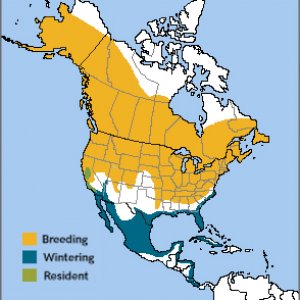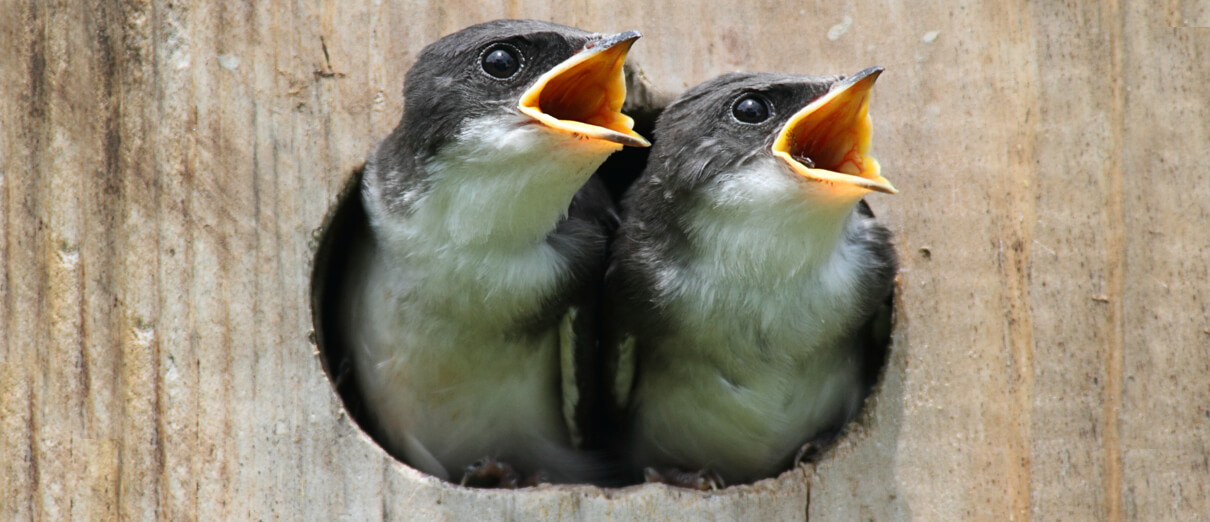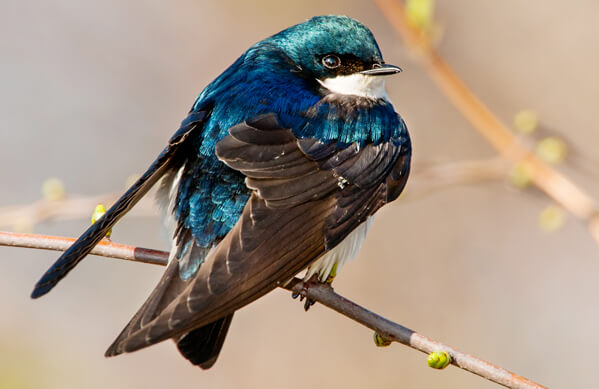
Tree Swallow range map by American Bird Conservancy
The elegant, eye-catching Tree Swallow is a welcome sign of spring in much of North America. Although named for its habit of nesting in tree cavities, this medium-sized swallow is most often seen in open spaces such as wetlands or farm fields.
Male Tree Swallows have shining blue-green plumage on their backs, contrasting gleaming white underparts. Females are less colorful, their backs ranging from dull greenish brown to almost as shining as the males'. Immatures are flat gray-brown above, with little or no iridescence. Tree Swallows show less white on the face and sides than is seen on the closely related Violet-green Swallow.
This sleek feathered aerialist leaves its breeding grounds later in the year than do its relatives the Barn Swallow and Purple Martin, and it returns earlier.
Dietary Versatility
Although Tree Swallows feed heavily on flying insects, they also eat more berries and seeds than do other swallows. This dietary versatility allows them to linger longer on their breeding grounds, migrate shorter distances, and return to nest sooner.
The habit of switching from insects to fruit as the seasons change is also noted in unrelated species such as the Yellow-rumped Warbler and Hermit Thrush, for the same reason.
Avian Tornadoes
Before migration, Tree Swallows congregate along shorelines in large flocks that can number in the hundreds of thousands. They migrate during the day in smaller groups, but re-gather every evening, forming dense, swirling tornadoes of birds, before descending upon a marsh or tree grove to roost for the night.
The Tree Swallow is a chatty species, constantly vocalizing with bubbly, liquid twitters and chatters, while perched and in flight.
(Audio: William Whitehead, XC544225. Accessible at www.xeno-canto.org/544225 )
Bluebird Neighbor
The Tree Swallow is a secondary cavity nester, laying eggs and raising its young in spaces excavated by other animals — often woodpeckers. There are many cavity-nesters in the bird world, including other swallows like the Purple Martin, and various others, including the Red-masked Parakeet, Mountain Bluebird, Gray-breasted Mountain-Toucan, and Resplendent Quetzal.
Tree Swallows are also quick to adopt artificial nest boxes when available, and efforts to help the Eastern Bluebird, Western Bluebird, and Mountain Bluebird by providing nest boxes have inadvertently helped the Tree Swallow as well. Many people now put up boxes in pairs — one for Tree Swallows and one for bluebirds. The arrangement seems to work well, with each species able to successfully raise young in close proximity to the other.

Tree Swallow chicks by Steve Byland/Shutterstock
The nest, built mostly by the female Tree Swallow within the cavity, is made of grasses, straw, and other vegetation, and is lined with other birds' feathers, which both birds bring to the nest. Both female and male Tree Swallows show a marked preference for white feathers, and may often be observed "playing" with one, dropping and retrieving it in mid-air, as they carry it to the nest.
Female Tree Swallows incubate the four to seven white eggs, brooding the young after they hatch. While the chicks are in the nest, usually two to three-and-a-half weeks, both parents feed them. Once they leave the nest, the parental “meal plan” lasts at least another three days before the young birds are on their own.
Lost Cavities and Tainted Waters
Although the Tree Swallow remains common throughout its range, the species is in decline, along with other aerial insectivores such as the Common Nighthawk.
The Tree Swallow is especially vulnerable to the loss of natural nest cavities due to deforestation, plus competition for remaining nesting sites, which are often dominated by the House Sparrow and European Starling, two introduced species.
In the wetland ecosystems they favor, Tree Swallows are exposed to industrial contaminants such as mercury and PCBs, which accumulate in the birds' tissues and may affect their nesting success.
ABC is currently leading efforts to stop declines in bird populations and to ensure that even relatively common species such as the Tree Swallow are safe from harmful chemicals, and more resilient to climate change and weather events. Find out how you can help.
Donate to support ABC's conservation mission!



















































